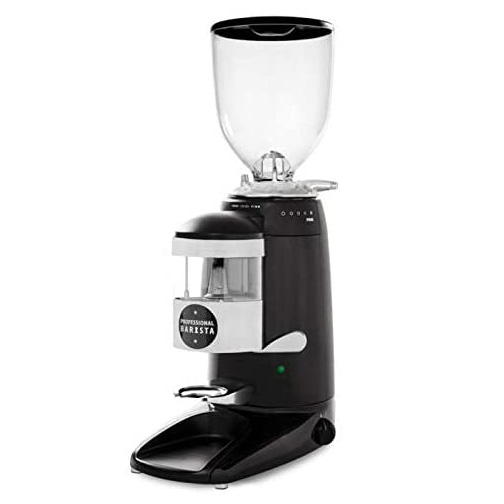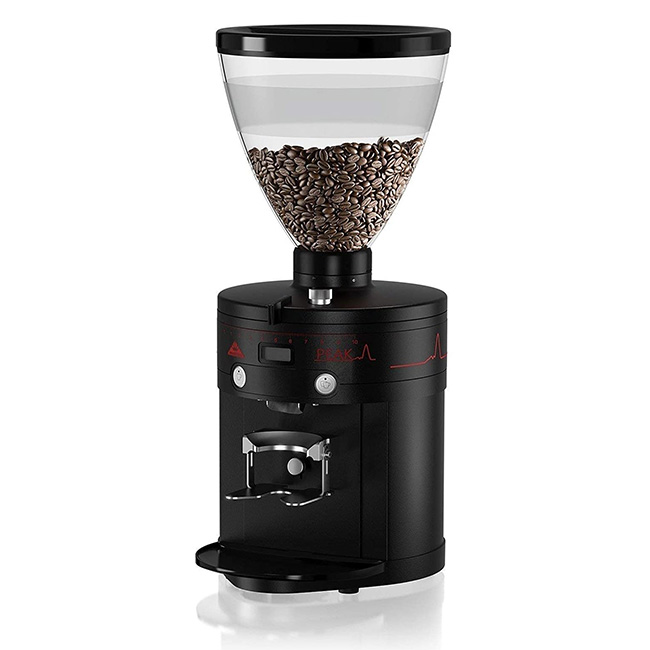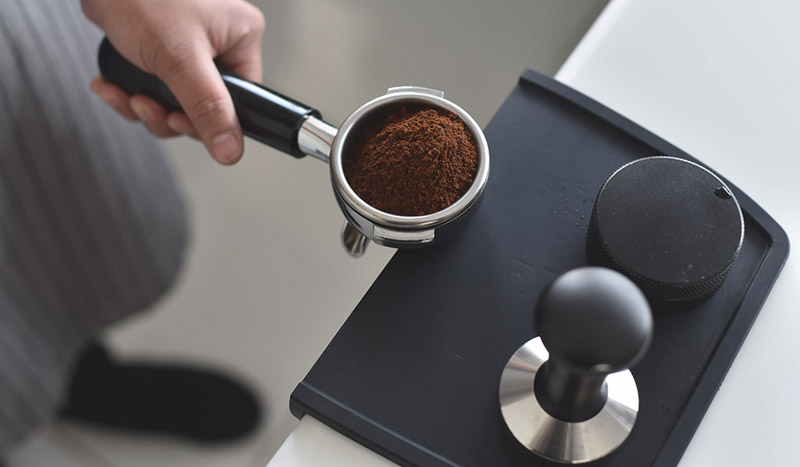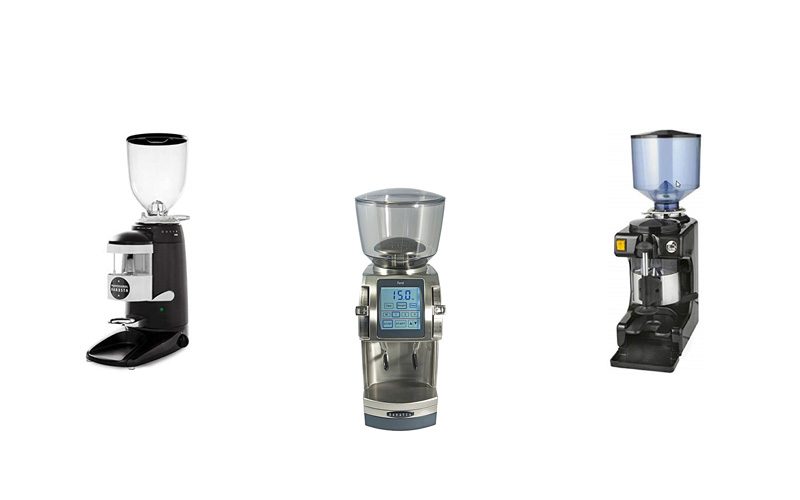We all know what a grinder does; it turns your beans into grounds that you will then use to brew coffee. So, what’s the difference between a normal and commercial coffee grinder?
- Bigger and better burr mechanism that gives you the ability to grind a greater amount of beans and also grind at a significantly faster rate.
- Better durability overall; however, this is especially most noticeable when it comes to the blades and other moving parts. This means that the grinder is built to handle more frequent use before it needs servicing or replacement parts.
- Better grind quality in terms of consistency and precision. Regular home grinders aren’t usually capable of creating extremely precise grind sizes.
- Better heat reduction which means that you will always get the intended flavors out of your coffee grounds. Heat reduction is especially important for a commercial coffee grinder that is going to experience frequent use
Editor’s Pick For Best Commercial Coffee Grinder: The Compak K10 Conic

Features – 5/5
Quality – 4/5
Capacity – 5/5
Pricing – 4/5
The Compak K10 Conic has a speed of 400 RPM and it is capable of handling over 35 lbs of beans in an hour, which is more than enough for even the busiest coffee shops. Most of the features that a barista needs are just one or two button presses away too.
Our 4 Best Commercial Coffee Grinders At A Glance
| Commercial Coffee Grinder | Pros, Cons & Caffeine Fiend Award |
|---|---|
 La Pavoni Zip-B Coffee Grinder Check Latest Price | Best Budget Pick + The low mounted motor has the benefit of reducing heat build-up + The grinding rate is relatively fast for its price range + It has an automatic stop function that protects the motor + It has a semi-automatic dosing function – It has limited settings for grind adjustment compared to the competition – It has no built-in timer |
 Baratza Forte AP Coffee Grinder Check Latest Price | Best For Compactness + It has a compact and lightweight build + It has a durable metal body + The belt drive system allows for quieter operation + It can be programmed with 3 preset grind setups – The hopper size is small for extensive commercial use – The portafilter usually slides during operation and so it needs to be held |
 Compak K10 Conic Coffee Grinder Check Latest Price | Editor’s Pick + Large hopper that can hold up to 3.75 lbs of coffee beans + Extremely quick and easy to use + Fast grinding rate + It produces a consistent fluffy grind that has minimal amounts of clumping + Powerful built-in cooling fan – Relatively expensive – Leftover coffee grounds will sometimes build up in the chute |
 Mahlkonig Peak On-Demand Coffee Grinder Check Latest Price | Best Premium Pick + The parts can be disassembled quickly for maintenance and cleaning + It has an automatic starting function that occurs once the portafilter is in place + It has a double ventilation system that provides fast and efficient cooling + It has an incredibly precise electronic grind control – It is relatively expensive – May need re-calibration after heavy use because the burrs may have become misaligned |
A Detailed Look At The Best Commercial Coffee Grinders
La Pavoni Zip-B Coffee Grinder — Best Budget Pick

If you’re shopping around for a commercial coffee grinder, you’ll be hard-pressed to find a reliable machine that falls under the $1000 price mark; however, the La Pavoni Zip-B manages to do just that. The La Pavoni Zip-B has cemented itself as the premier affordable choice for up and coming coffee shops that are operating on a strict budget. Even though it is affordably priced, the La Pavoni Zip-B is still capable of delivering a consistent grind size and it also has a relatively fast grind rate – about 13 lbs of coffee beans per hour.
However, the La Pavoni Zip-B does have its drawbacks which are probably meant to compensate for its affordable pricing. First off, it doesn’t have a timer, which is honestly not a necessary feature but it is one that has become the norm on high-quality commercial coffee grinders. Secondly, compared to the competition, the La Pavoni Zip-B has a relatively limited grind adjustment setting.
Baratza Forte AP Coffee Grinder — Best For Compactness

We’re sure that you can find a smaller coffee grinder that technically also has commercial grade parts; however, the Baratza Forte AP does the best job of merging quality and compactness. It has fairly durable metal construction and is relatively quiet due to its belt drive system. It is also fairly programmable, with the ability to have three preset grind setups.
One of the most glaring downsides of this grinder – which is to be expected – is its overall coffee grinding capacity. Baratza’s official statement on the Forte AP claims that the machine’s coffee grinding capacity is about 5 lbs per day. This is an important fact to keep in mind because you can easily find commercial coffee grinders that can handle three times that amount in just one hour. That being said, the Baratza Forte AP is a great choice for coffee shops that can support their larger devices by taking on specific lightweight responsibilities, like making decaf.
Compak K10 Conic Coffee Grinder — Best For Ease-Of-Use

Nowadays, most contemporary commercial coffee grinders are built with usability in mind. However, that being said, the Compak K10 Conic takes the expected level of usability and cranks it up to 11. What this means is that the Compak K10 Conic is therefore perfect for baristas that probably don’t have a lot of experience under their belt, since most of the features that they will need are just one or two button presses away.
The Compak K10 Conic has a speed of 400 RPM and it is capable of handling over 35 lbs of beans in an hour, which is more than enough for even the busiest coffee shops. The Compak K10 Conic is also capable of delivering a consistent fluffy grind, that has minimal amounts of clumping, due to its set of high quality 68 mm conical tempered steel burrs.
Mahlkonig Peak On-Demand Coffee Grinder — Best Premium Pick

The Mahlkonig Peak On-Demand is the most expensive commercial coffee grinder on our list (but not the most expensive one on the market) and if you can afford its asking price it is definitely worth the purchase. The most noticeable feature of the Mahlkonig Peak On-Demand is its 80 mm special cast steel burrs that are incredibly effective and are capable of creating a perfectly consistent grind.
The Mahlkonig Peak On-Demand is also built to handle extended periods of heavy use, having a double ventilation system to prevent overheating and easy to use electronic grind controls for fast and efficient operations. Having said that, even though it is built to handle heavy use, it is still going to need regular recalibration from time to time, specifically to make sure that the burrs are aligned correctly. However, recalibration for issues such as this should usually take no more than 5 minutes.
How To Choose The Best Commercial Coffee Grinder: The Ultimate Buyer’s Guide

Conical Burr vs Flat Burr Grinders
It should honestly go without saying that if you’re planning on buying a commercial grinder, it needs to be a burr grinder. However, when it comes to burr grinders, coffee aficionados are split into two camps; those who prefer conical burr grinders and those who prefer flat burr grinders. The primary reason why there is a lot of debate over these two types of burr grinders is simply that none of them is outright better than the other – doesn’t matter if you’re talking about home brewing or commercial coffee-making.
| Conical Burr Grinders | Flat Burr Grinders |
|---|---|
| Pros: Easier to adjust Great for espresso Less heat and noise Cons: Having two sizes of ground particles can create unbalanced extraction | Pros: A greater level of customization Creates a uniform grind size More balanced extraction Cons: More heat and noise Easier for grounds to get stuck over time |
Conical Burr Grinders
Like the name would suggest, conical bur grinders have a distinct cone-like shape, which naturally guides the beans downwards and through the blades. Even though they aren’t outright better than their counterpart, you will find that when a coffee shop is looking for a commercial coffee grinder, they will oftentimes opt to use a conical burr grinder. One of the main reasons for this is simply because this type of burr grinder is viewed by many as the norm for commercial use.
Another reason is that conical burr grinders create ‘bimodal particle size distribution’ and many coffee shops want that for their grounds. Bimodal particle size distribution is just a more technical way of saying that when you use the grinder on your beans, you will get a mixture of two different grind sizes. This difference in size isn’t going to be easily noticeable to the naked eye but it is going to produce a varied rate of extraction during the brewing process. Overall, conical burr grinders are recommended for espresso because the bimodal particle size distribution can easily create a stronger brew.
Flat Burr Grinders
Flat burr grinders get their name from the way that their blades are positioned – flat burrs have two horizontal blades. Flat burr grinders create ‘unimodal particle size distribution’ which means that all of the grounds that you get are going to be identical in size. Advocates of conical burr grinders state that unimodal particle size distribution is subpar when it comes to espresso and so perfectionists that want to brew espresso usually steer clear of this type of grinder. However, that being said, flat burr grinders excel at other brewing methods; such as French press and pour-over, due to the aforementioned unimodal particle size distribution.
One issue that some baristas have with flat burr grinders is that it is easier (compared to conical burr grinders) for coffee grounds to get stuck. In addition to this, flat burr grinders are noticeably noisier than their conical counterparts and they also produce more heat.
Doser Or Doserless Grinders
Your commercial coffee grinder being a “doser” or “doserless” grinder has nothing to do with the actual way that the beans are ground. Instead, this is just a way to describe how the coffee grounds are dispensed after the grinding process.
Doser Grinders
Doser grinders have a container or a chamber where the fresh coffee grounds are deposited and also a way to dispense set amounts – usually a lever. However, there are electric grinders that have convenient automatic dosers that are programmable. Overall, this type of grinder is great for busy coffee shops and for individuals that value precise measurements.
Doserless Grinders
As the name would suggest, doserless grinders are the exact opposite. They don’t have a container were fresh grounds are collected; instead, the grounds are deposited straight into your portafilter or grounds bin. This type of grinder is great for baristas that want to have more control and fewer containers to clean. In addition to this, doserless grinders help to guarantee the freshness of your coffee.

Stepped vs Stepless Grinders
If you’ve been shopping around for a commercial coffee grinder, chances are that you’ve seen them being described as either stepped or stepless. In short, this has to do with the grind settings of your machine. However, it is not focused on the available grind sizes; instead, it deals with how the machine allows you to select your grind size.
| Stepped Grinders | Stepless Grinders |
|---|---|
| Pros: Beginner-friendly; easier to use Great if you need different grind size on short notice Cons: More limited grind options | Pros: More precise and gives you more control Leads to better coffee extraction Cons: More involved and complicated |
Stepped Grinders
This is the type of commercial coffee grinder that most people are familiar with because they are easier to use (and therefore coffee shops will opt to use them). When you adjust the grind size of a grinder with stepped settings you will usually hear a click that corresponds to predefined increments. In addition to this, stepped grinders will also usually have a visual numerical representation of how fine or course the grounds will be.
Stepless Grinders
Stepless grinders will have no audible clicks or notch increments and as a result, they give baristas significantly more freedom. However, nowadays there are some stepless grinders that come with visible markings or numbers that act as a guide.
Manual vs Programmable Grinders
In this day and age, you’re probably wondering why any coffee shop would opt to use a manual commercial coffee grinder when programmable alternatives exist. However, surprisingly enough, there are some clear benefits to using a manual grinder in your coffee shop – or at least having one that can work alongside your programmable grinders.
Manual Coffee Grinders
One of the primary benefits of manual grinders is that, on average, they are significantly cheaper than their programmable counterparts. In addition to this, baristas don’t have to worry about dealing with complicated electronics and repairs are easier to carry out. The main downside is that that this type of grinder is going to need to be manually calibrated and set up several times throughout the day.
Most coffee shops that have manual coffee grinders won’t opt to use them exclusively. Instead, they will use manual grinders – usually for minor tasks – alongside their programmable coffee grinders.
Programmable Coffee Grinders
A programmable commercial coffee grinder is usually what you are going to see when you visit a coffee shop nowadays. These grinders usually value speed and effectiveness above everything else and they oftentimes take a lot of the work off of the barista’s hands. They can usually be programmed to perform several different operations with just a few button presses.
The only downside to getting a programmable coffee grinder is that they are expensive and so because of this, they are often viewed as an investment.
Choosing The Best Commercial Coffee Grinder: Understanding Your Needs And Limitations
It is always important that you remain mindful of the current needs and limitations. If you’re buying a commercial coffee grinder for your coffee shop, you need to ask yourself a few questions:
- How many customers will I be serving each day?
- What kind of variety will I be offering?
- How much space do I have available?
- What budgetary limitations do I have?
Questions like these are important because only you can accurately answer them and the size, features, and price of your commercial coffee grinder will depend on your answers.

